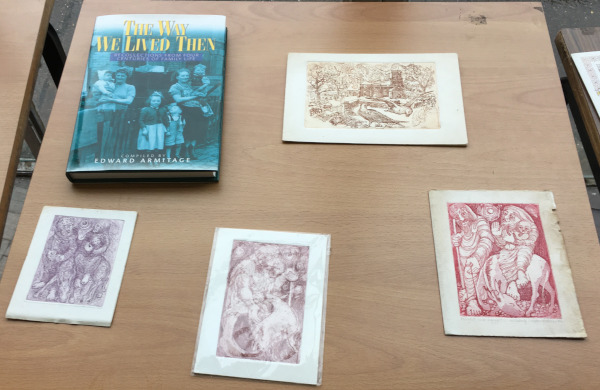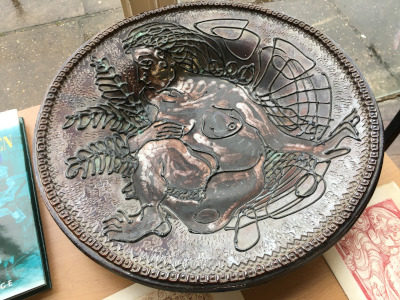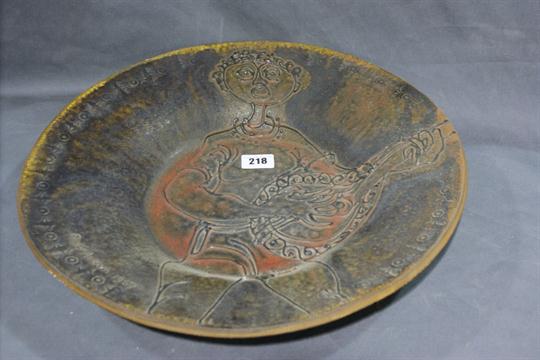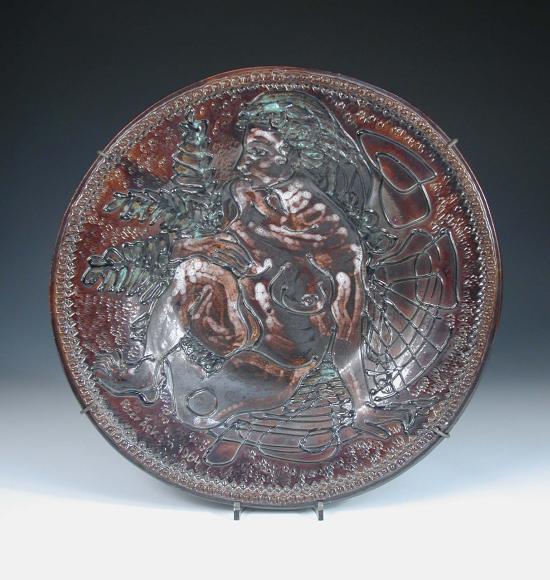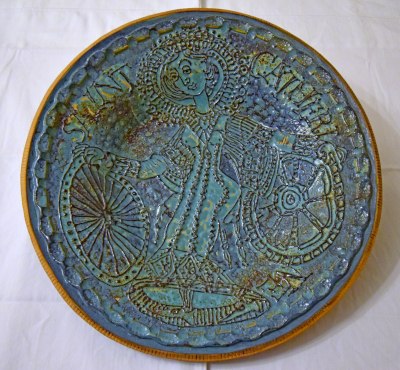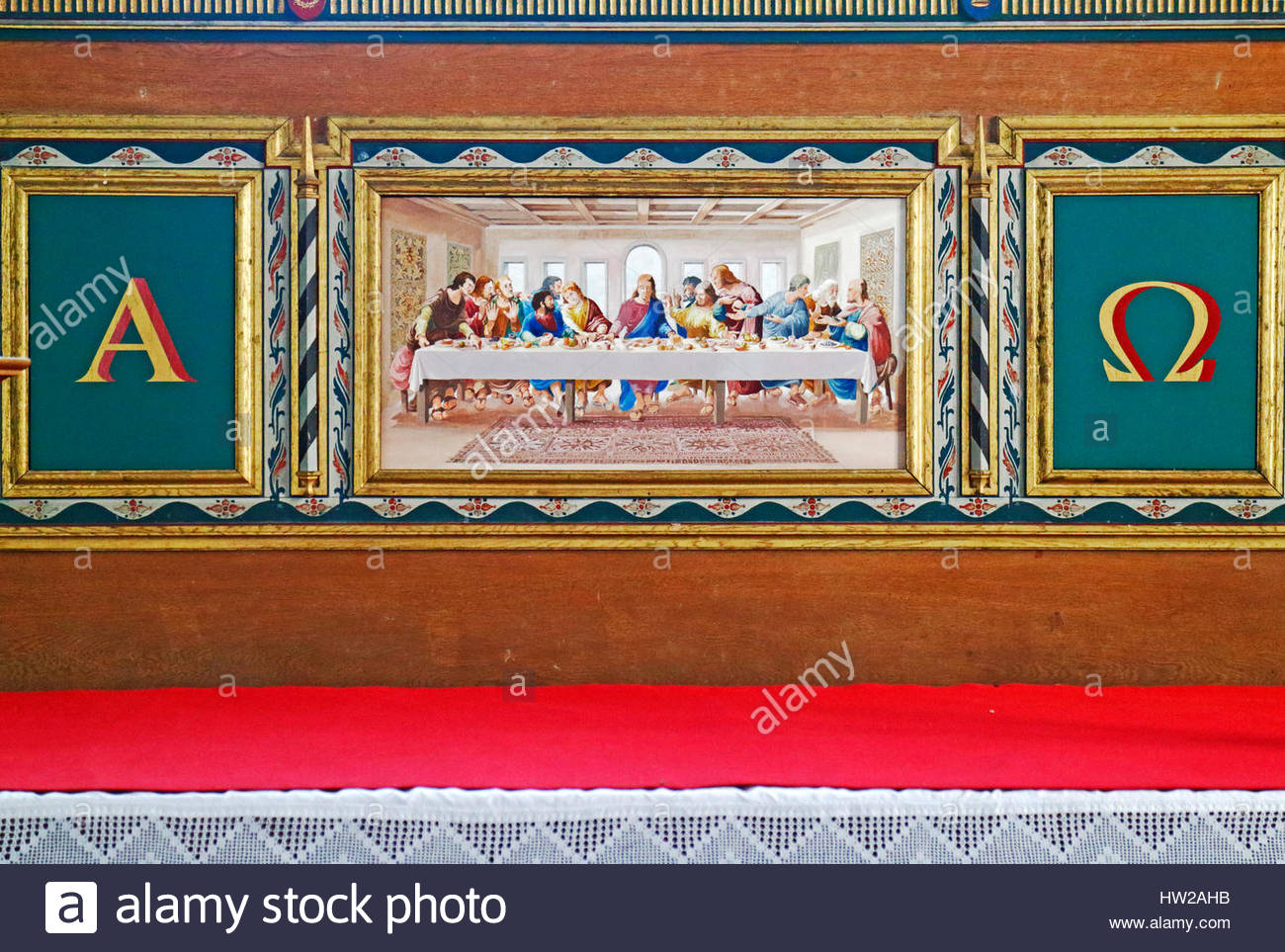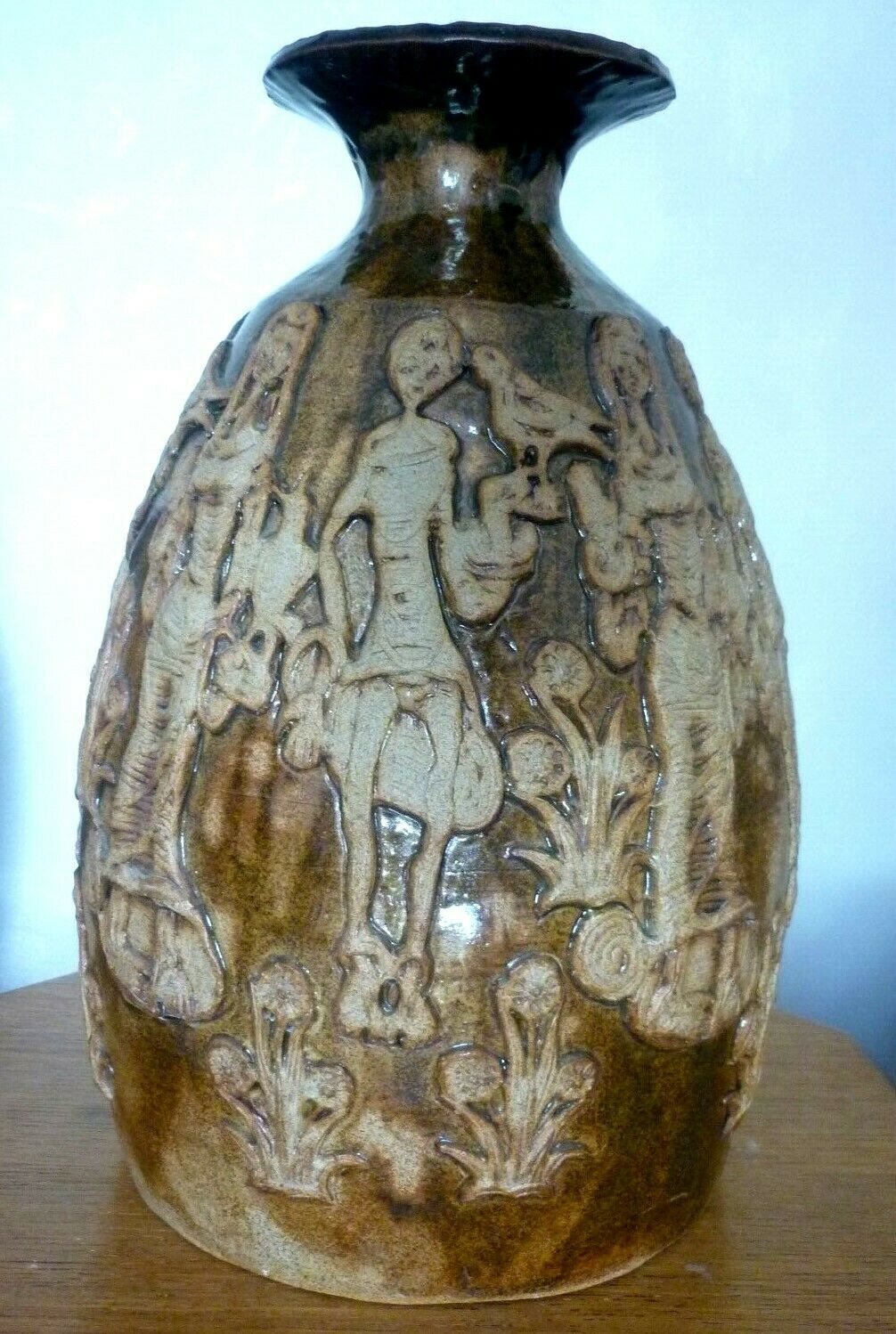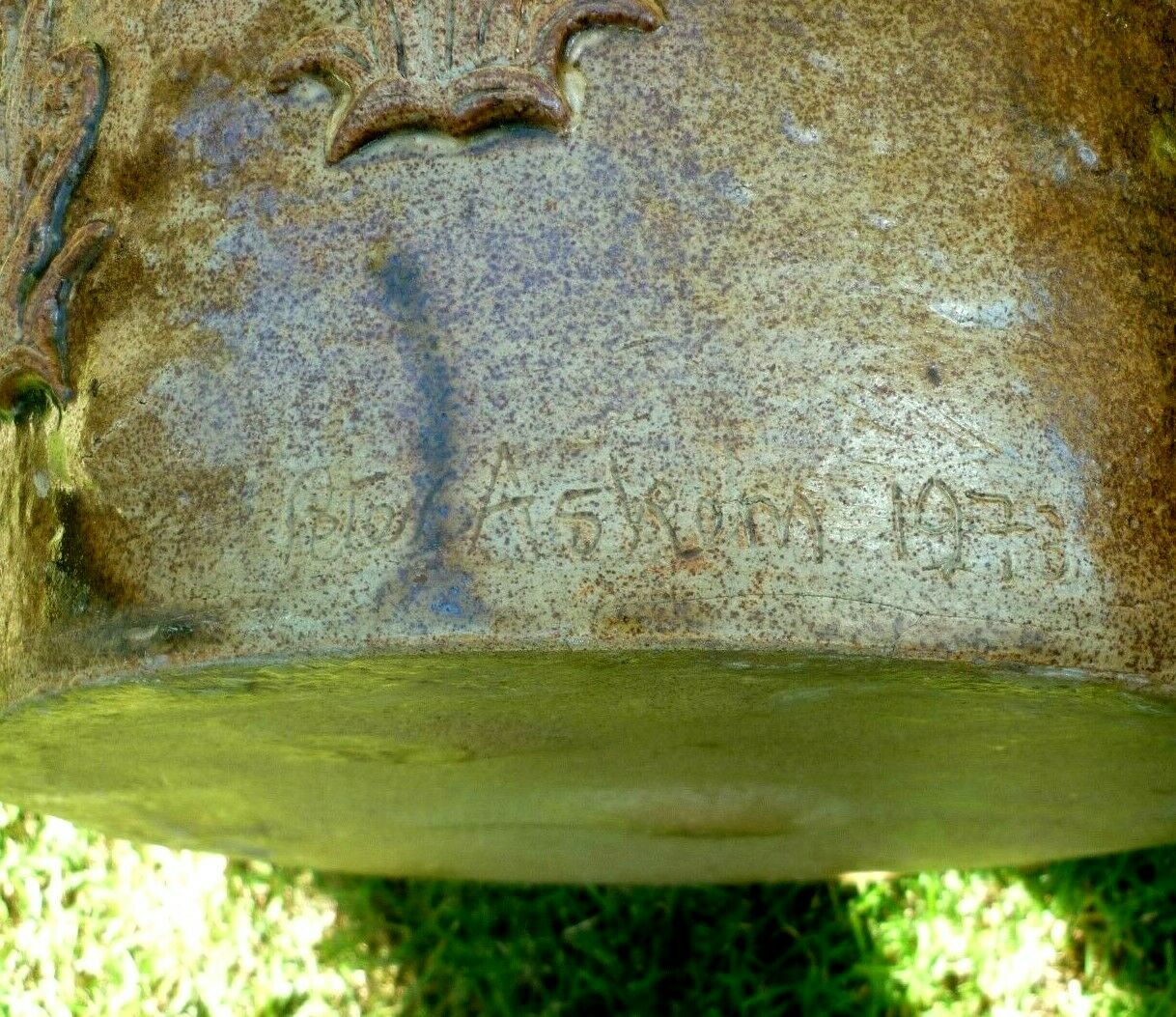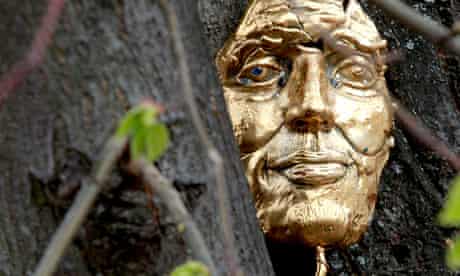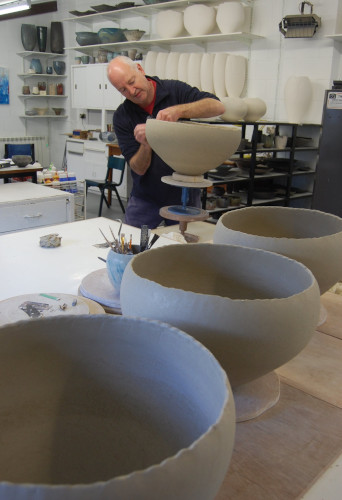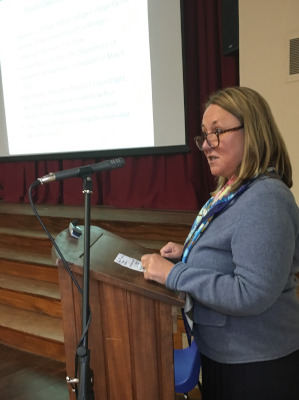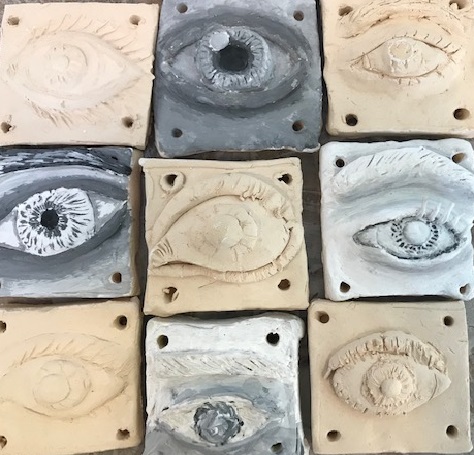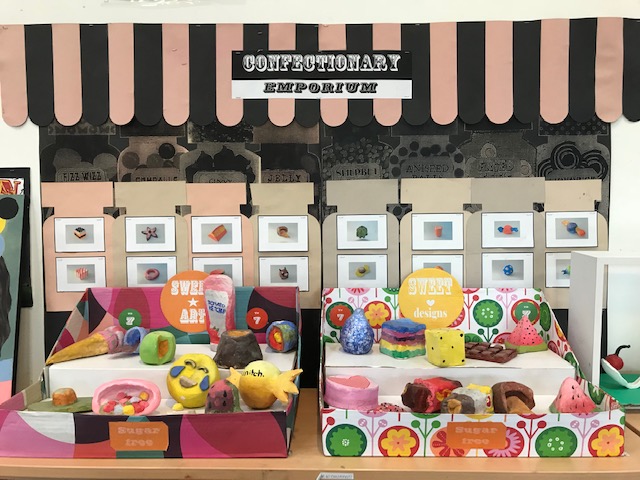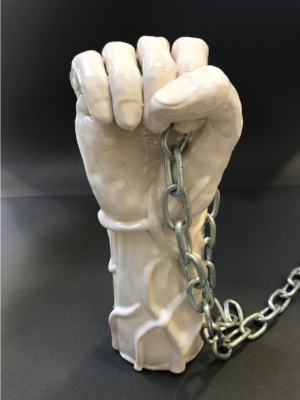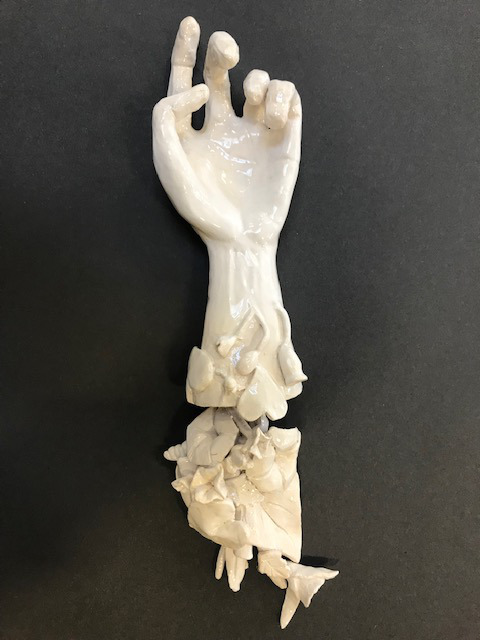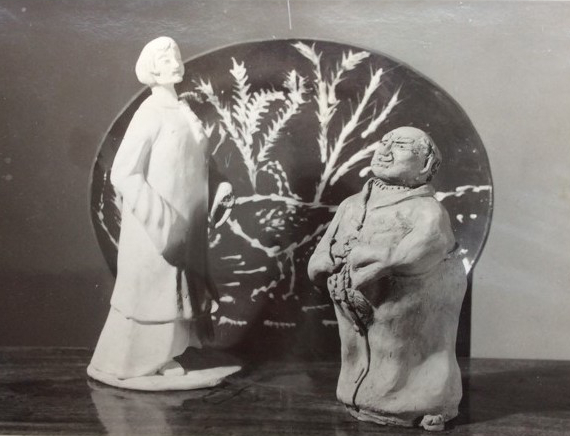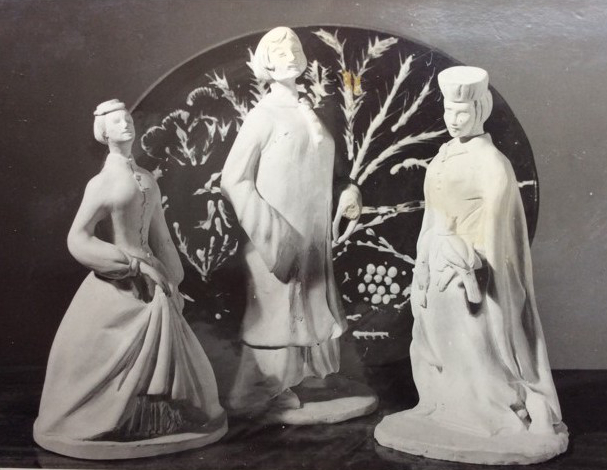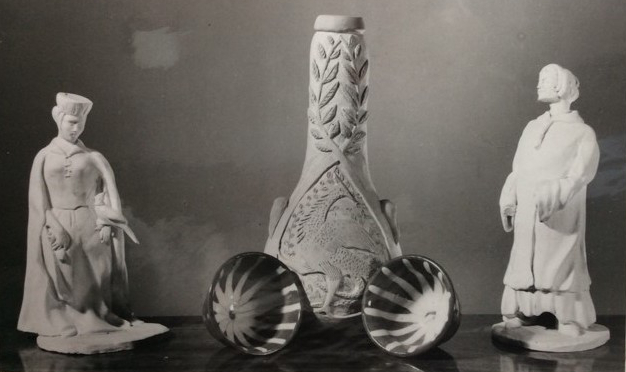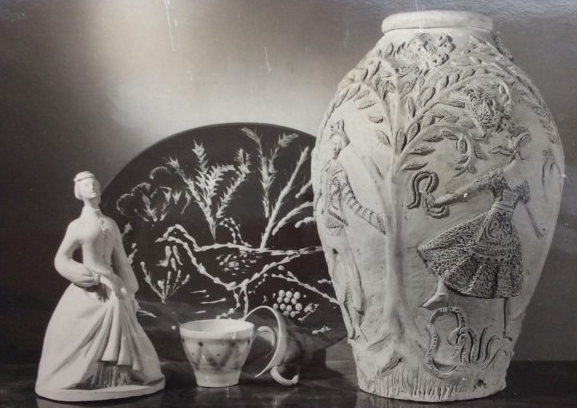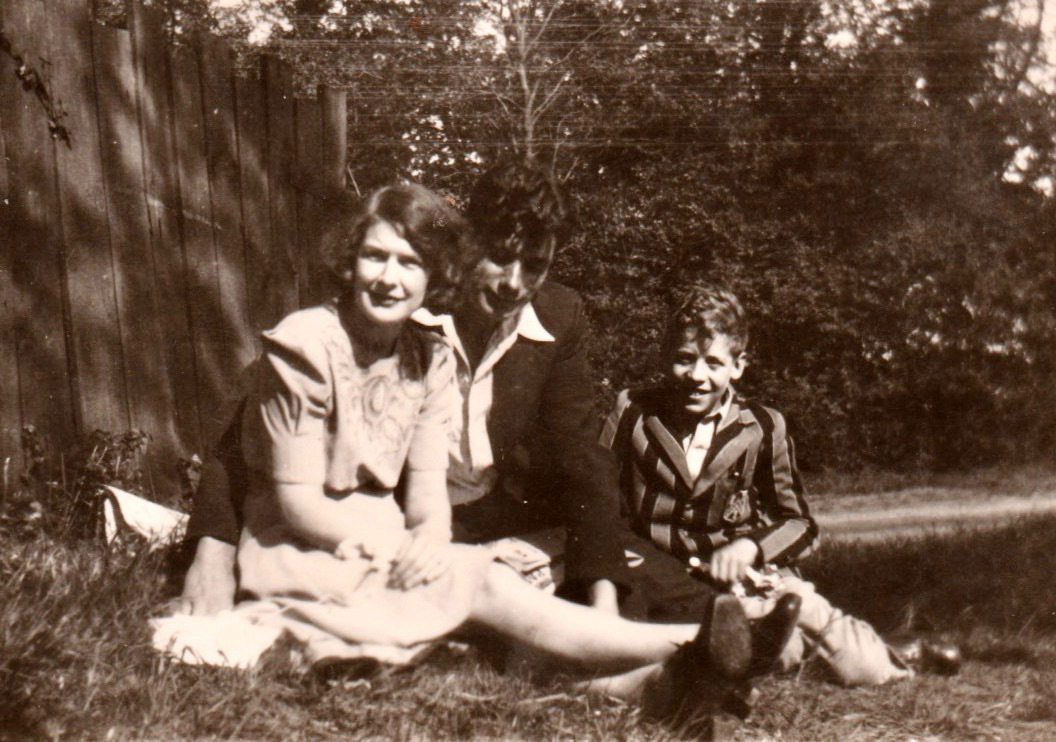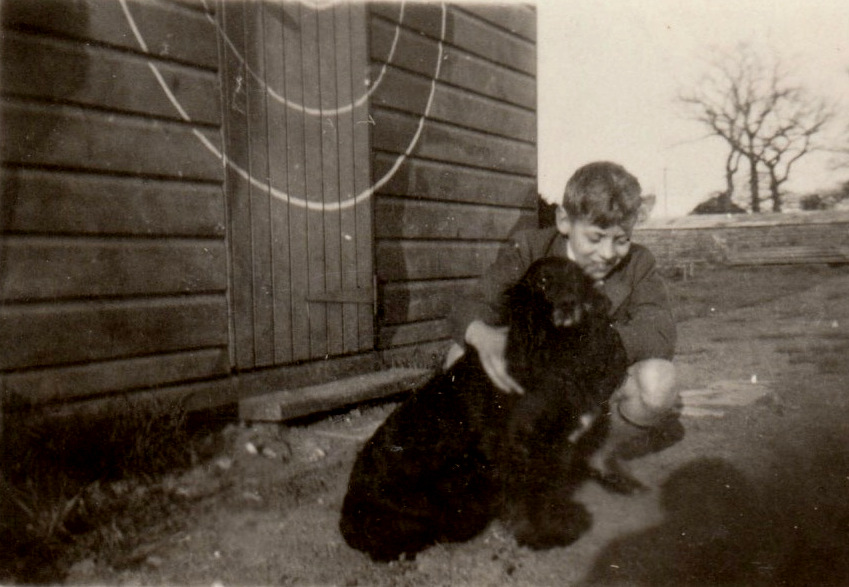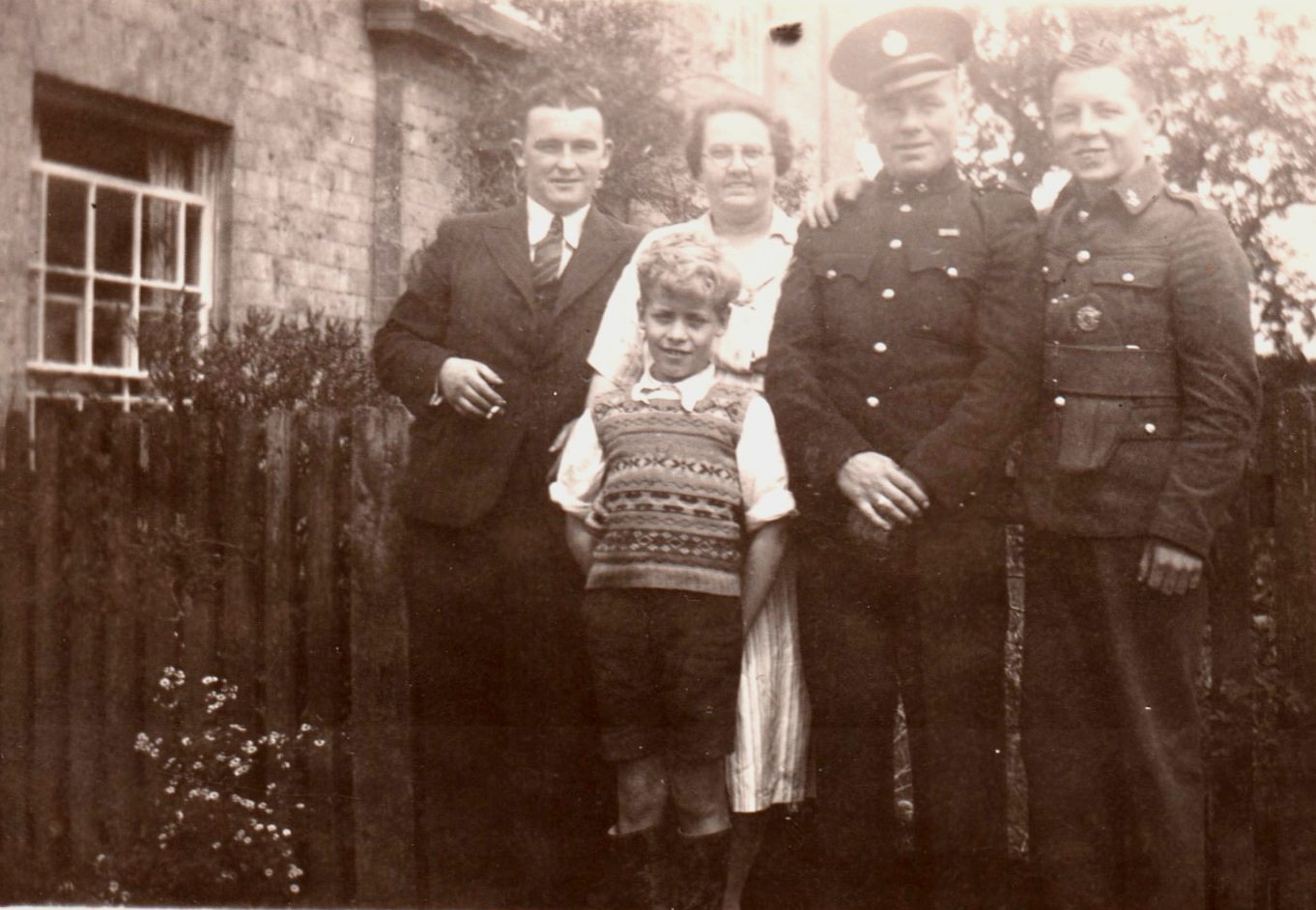|
On 17th April 2018 we learned of
the death of Mr Peter Askem. He died on 18th February
2018 at the age of 87.
A Thanksgiving Service for his life was held at at St Andrew's Church, Letheringsett, Norfolk on Thursday 5th April 2018. The service was taken by The Reverend Libby Dady, Rector for the Glaven Valley Benefice. Mr Chris Wain (Maths 1966-70)
represented the Soham Grammarians.
The first hymn was Just As I Am. A Tribute was given by his son Andrew. Time for Reflection followed whilst Crimond was played The Reading was John 14: 1-6, 27, read by Peter Brice. The second hymn was O Jesus I have Promised (Thornbury). Prayers, including The Lord's Prayer. The third hymn was Dear Lord And Father Of Mankind. The Commendation. The final hymn was Praise My Soul The King Of Heaven, during which Reverend Libby left the church for the Committal at Cromer Crematorium. 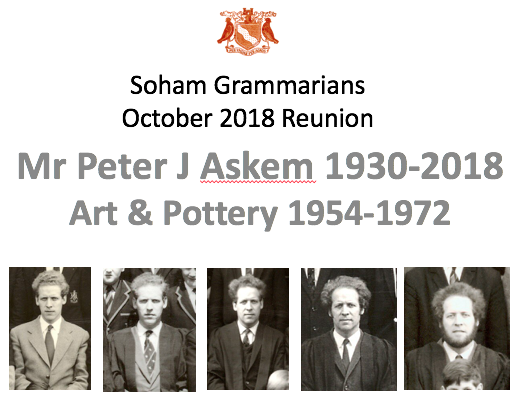 Frank
Haslam SG'59' thanked Tamaris Taylor, Peter Askem's
eldest daughter (who was at Ely High School) for coming over
from Ireland to take part in this talk about her father.
Mr Dick Bozeat (Woodwork 1959-72) and Barry Parr SG62 would also speak and there would be contributions given by Frank on behalf of many others. The talk was broadly as follows:
If you have further photos or recollections to add to this page please make contact. Peter’s last contact with the SGs was on 15 August 2017, about our 2017 Reunion. "I have
been quite ill now for about eighteen months but my health
seems to be making some improvement.
I am
awaiting another session in hospital in early October.
I had hoped
to be able to make it to the reunion lunch this time but
taking all things into consideration that will not be
possible.
Please accept my good wishes and share them with all who may remember me. Peter."
Frank:
Let's share some memories of Peter and, if you like, this be
our way of returning our good wishes to him.
Peter
Joseph Askem was born on 13 March 1930, to a farming
family in Wrestlingworth, in Bedfordshire, four and a half
miles NE of Biggleswade.
Soham (top
right) and Wrestlingworth (red indicator) are shown below:
 (c)
Google Maps
Research in the British
Newspaper Archive shows that Peter was soon appearing
in the local Press:
Biggleswade Chronicle -
Friday 25 September 1931
WRESTLINGWORTH. Nursing Association Fete … baby competition. Prizes were as follows … Under 18 months. 1st Peter Askem, Wrestlingworth Bedfordshire Times and Independent - Friday 14 October 1932 WRESTLINGWORTH WEDDING [of his mother's sister Miss Connie Bates to Mr A Arnold] …. The train bearers were Master Peter Askem and Master John Bates, who wore blue satin suits. [Tamaris thinks there is a
photo of him at that wedding]
Biggleswade Chronicle -
Friday 10 May 1935
SILVER JUBILEE in the district – WRESTLINGWORTH Peter Askem placed in two competitions … and so it
went on!:
Bicycle/Tricycle competition 1938
Red Indian Fancy Dress 1940 Warship Week Slogan 1942 Poster competition 1945 And, shades
of things to come ...
Biggleswade
Chronicle - Friday 24 February 1950
The Women’s Institute gave a repeat performance of two plays … Peter Askem painted scenery.
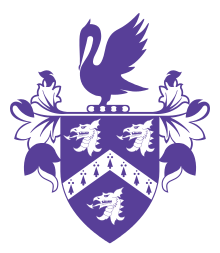 AT THE PERSE SCHOOL,
CAMBRIDGE
Frank: Tamaris tells me Peter won a scholarship to the Perse School in Cambridge. Peter wrote to me in 2010 a little about his time there. "Stanley Stubbs rings
many bells in my mind as he was my Headmaster during quite a
number of years whilst I was a schoolboy at The Perse.
He was a very fair man in contrast to the previous Head who was very harsh. One of the very old school types." 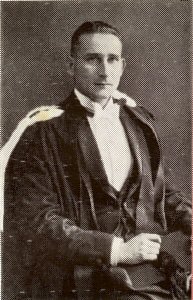 Stanley Stubbs, 1940
"Cecil
Crouch was my Art Teacher and encouraged me so
much. The previous Art Teacher was a Scot and used his
belt on us."
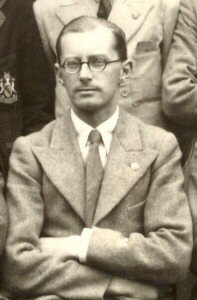 Cecil Crouch, 1937 Both
photos relate to Soham Grammar School. Mr Stubbs was
Headmaster 1940-45 and Mr Crouch taught Music and Art 1926-45.
Mr Crouch and the School Secretary (Miss M Gimbert?) followed Mr Stubbs to the Perse. Tamaris:
He had won a scholarship to the Perse School for Boys where he
did very well academically and became Head Boy. The Perse
encouraged him towards medical training. He did turn up on the
first day for a post-mortem and fainted, so that was the end
of that.
Eventually
he decided to go to Art School much to the disappointment of
his parents and aunts and uncles who I remember were still
talking about it years later when I was a child.
He applied
to Central
St Martin's School of Art to study Illustration,
Drawing, Printmaking and Furniture Design. We are not sure of
where these two photos below were taken but possibly they were
at St Martins.
Could that
be Peter on the right of the larger photo?
His parents
were very church orientated and had a hope that Dad would
become a vicar as it became clear that he was not interested
in farming. He started as a choirboy quite assiduously. His
father played the organ in church (as did his mother).
One of my earliest memories is of sitting with Grandad Askem
at the organ on Sundays and pulling the stops when he
indicated. He always did the Sunday service in Wrestlingworth
and Nana (my Grandmother) sang in the choir. They were very
musical and I think Dad inherited that as well as he was a
wizard on the piano.
The Aunts were a huge part of my life and were always very kind and very old-fashioned. 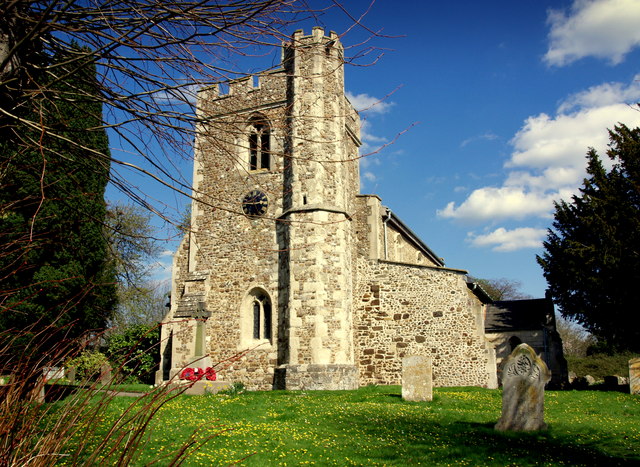 St Peter's Wrestlingworth, where Peter's parents were much involved in parish activities and music 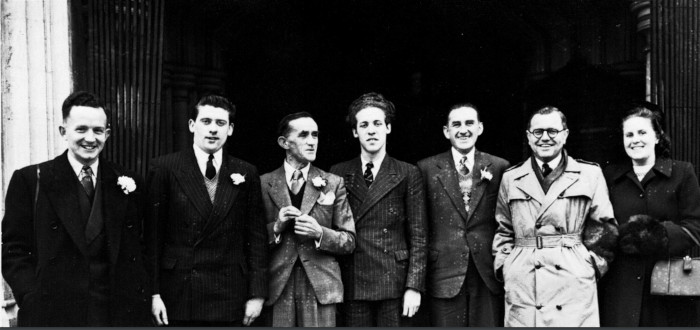 We don't know about this photo, which seems to be of Peter at a wedding judging by the buttonholes sported by some. His first job after St Martin’s was as Assistant Art Director on the film Genevieve with Kenneth More and Kay Kendall, where his claim to fame was rushing out of the set one day to buy the leading lady a new pair of silk stockings, about which he talked for many, many years afterwards. 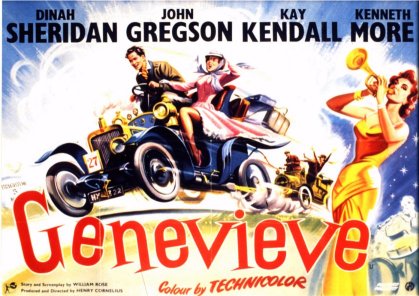 [Frank: Some of my vintage (59-66) can recall this 1953 film being shown in the Assembly Hall (Beechurst). Did Peter have a hand in that choice?]
Realising that the world of film
was not for him, and was a bit precarious for someone
beginning his family, he needed to take a much steadier job so
he began to look into teaching.
That would lead him to Soham
Grammar School with Edward Armitage as headmaster.
Biggleswade
Chronicle - Friday 27 August 1954
WRESTLINGWORTH Mr. Peter J. Askem, son of Mr. and Mrs. J. Askem, of Church Lane, is hoping to take up an Art Master’s position shortly. He has succeeded in passing the Ministry of Education Intermediate Examination in Arts and Crafts (1951) and has obtained the National Diploma in Design (1953) and the Art Teacher's Certificate of the University of London Institute of Education. He is a
former pupil of the Perse School at Cambridge.
Peter's
predecessor was Mr Ken 'Dilly' Drake (Art & Pottery
1948-54), who was a boy here 1929-37.
He was very successful on both of his periods here. He left to become Head of Art at the huge ground-breaking Kidbrooke Comprehensive School for Girls in London. He died in 2002. Ken was
the first occupant of one of the school houses in Sand
Street, followed by Leon Kitchen, the Askems and now and for
many years by Mr Peter Scott!
more details
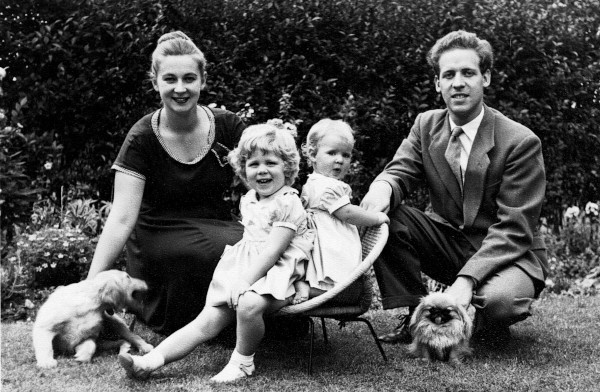 With me and my younger sister 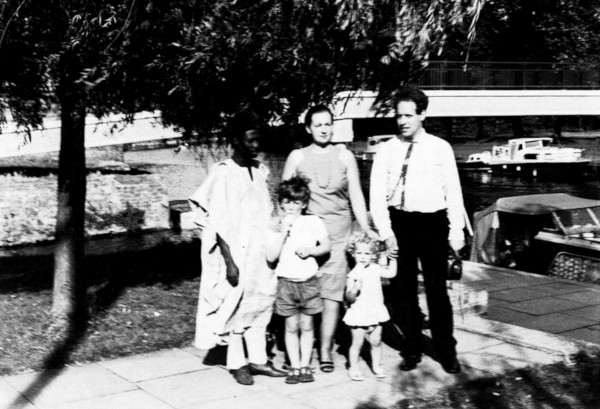 This is my youngest sister
and brother with my parents
and a visitor from the Ministry of Education from Kenya. From the SG Archives
Here are the other images of
Peter, extracted from the School Photos.
Together with the 1956 one,
they appear on the title slide of this talk, shown above.
THE LAND OF ART AND POTTERY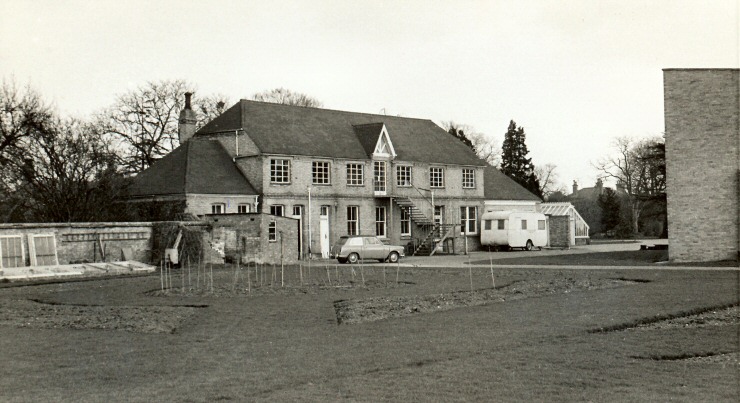 For many years Art and Pottery
was up those metal stairs, above Metalwork and Woodwork -
taken in 1966 by Gwyn Murfet SG56
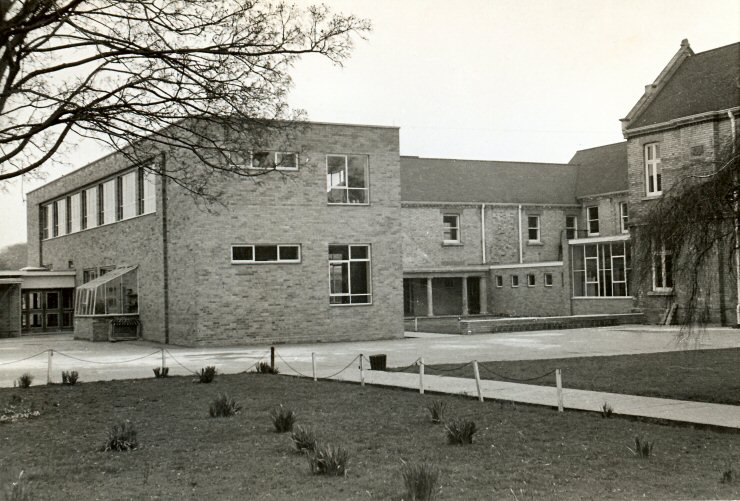 Then the new buildings came
along in the early 1960s.
Art and Pottery was on the
upper floor in the block on the left with Biology underneath.
Note the Cloisters in the
middle and the tall windows of the Exhibition space where the
Conservatory used to be.
Taken in 1966 by Gwyn Murfet
SG56
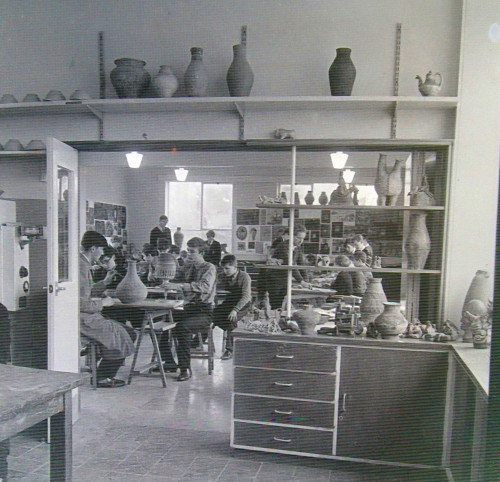 The Art/Pottery Studio 1966. Phil Leslie 59 and Rod (Rocky) Ward 59 seated on left. PJA in the middle Dick Bozeat standing at back? source: Brian Lane/Mike Petty. Used in the School History 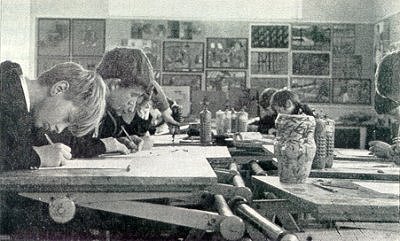 from an article in Cambridgeshire Huntingdon & Peterborough Life, January 1970 ProductionsTamaris: Dad loved
painting sets for school productions and making outfits and
costumes with my mother's help at home with a sewing
machine.
I believe that some of you
still have your cardboard Roman soldiers breastplates and
swords.
Frank: The late Gordon
Hemmings (English 58-66) provided me with his
unpublished account of putting on a production in a rural
grammar school - The Play Produced: The Winter's Tale.
He wrote:
In our early discussions
about the set, it seemed natural that the designer (our
Art Master) and I should decide on the simplest of basic
sets, rejecting the idea of a front curtain, and throwing
out an apron stage towards the audience, in the now
familiar Stratford manner. On stage left we planned an
elaborate arrangement of levels and connecting steps,
rising to a height of about five feet, and to balance this
on stage right - though set further back - an erection
which was variously christened the bird cage, the pagoda,
the temple or the gazebo, according to mood.
Six slender double columns
supported a vaulted roof, though with only two ribs
actually showing: this began as quite an elaborately
decorated object, but when we eventually saw it in
position on stage, we cancelled all further additions to
it and were very happy with its graceful silhouette,
interesting from all angles. Scene changes were to be made
in front of the audience by uniformed attendants, who drew
tapestries to conceal the bird-cage and to vary the
backing behind the levels to suggest interior or exterior
settings.
Originally we had hoped to
drop down these tapestries from above, but lack of height
above our stage made this idea impracticable, and we were
finally much better pleased with the forced alternative.
As often in school productions, apparent limitations can
prove unsuspected assets.
I was very anxious to emphasise the fantastic 'old tale' elements of the play, and we decided to dress it in a freely interpreted fairy-tale-Byzantine style, and to make liberal use of music. We are very fortunate in having the tradition of designing and making our own costumes: the designer's first sketches assured me that he had caught exactly the right contrast between the almost barbaric splendour of the Sicilian court and the gentle, but not too pretty, pastoral world of Bohemia. And so throughout the term
these sketches were excitingly turned into real costumes
by mothers of the cast and friends of the School; many of
the details - brooches, painted panels and so on - were
made by the boys themselves. By concentrating on achieving
variety of texture with such materials as were available
the designer was able to work on a comparatively limited
range of colours: gold and browns in the Sicilian half of
the play, with the addition of greens and yellows when
Bohemia was reached, with a mourning court in greys and
purples for the return to Sicilia.
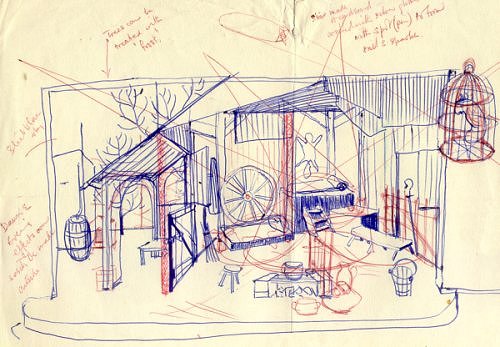 Gordon commented "so closely realised" Here are
some of the productions designed by Peter: links to reports
are provided:
The XIVth
Legion July 1969
 Mrs Kathy Howells (Biology
68-69) "Mr Taylor presented me with two bolts of brown
fabric and told me to organise costumes. I had to
measure every boy in the Lower School to work out how much
material was needed for his Roman tunic as there was only just
enough to go round!"
SOME
OTHER THINGS THAT (SOME OF US) KEPT ...
Albert Ware SG52 "Not
sure if this will be of interest....
but this pot was part of my O Level Art exam during 1956 when taught by Peter." 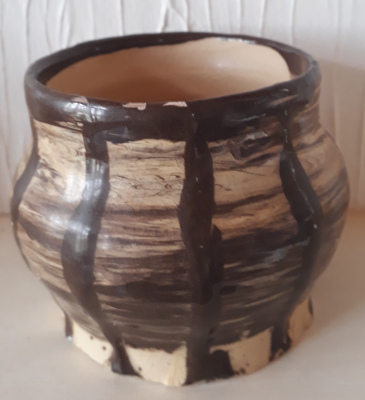 Ed Reed
SG67: "My recollection is that we made thumb pots in the
second form, when Dick Bozeat was our form tutor.
Pete Askem
asked us to get some clay from the clay “pug” machine which
was in the ante-room at the end of the main art classroom.
He asked as
to mould it into the shape of a rounded pebble similar to
which one may find worn smooth by flowing water in the bed of
a stream.
We were
then asked to make an indentation in the top and gradually
hollow it out using our thumbs, hence the term thumb pot.
When
finished we had to let the pot air-dry, for about a week I
think, before firing it, otherwise it would have cracked if
there was too much moisture in the clay.
This was
our first effort at pottery before we moved on to what were
called 'ring' or 'hoop' pots.
We never
quite progressed to the potting wheel, which was probably very
wise as you could imagine the mayhem which could have ensued.
Some boys were much quicker at producing pots that others which I recall gave a lot of time for making pea shooters with balls of left over clay and milk straws which were readily available from the issue of free school milk at the time!" 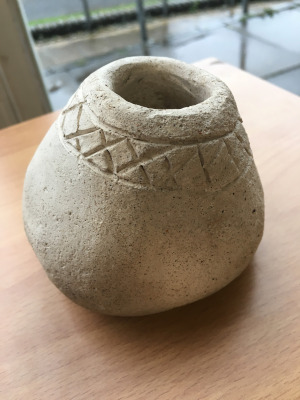 Ed Reed's thumb pot
Dr Bob
Tyler SG62 - "I’ve dug out this now rather battered clay
figure which I made with Mr. Askem in 1963 when I was in class
2A (aged 12).
The figure
originally had a pipe!
He was an
inspirational teacher and although I didn’t continue with Art
and Design professionally, I have spent the rest of my life
designing and making gardens as a serious hobby."
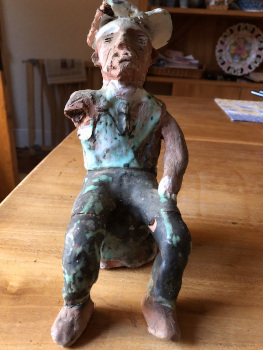 Soham Grammarian - further extracts relating to Peter AskemNew Year 1955Art Club - The Club's usual high standard of work has been maintained under the new management of Mr Askem. A considerable amount of work has been done, both in the Art and Pottery sections. Summer 1955 Mr Askem, too, entered into a perilous world - the world of married bliss (or otherwise). We offer him our heartiest congratulations and more especially as his wife is the School's new Secretary. Mr Askem has taken of the reins (or should I say taken over the wheel?) from Mr Drake but he seems rather uncertain whether or not he should use the whip. However,
his few isolated threats and warnings of retribution keep us
on the straight and narrow path to artistic ideals.
New Year 1957 Congratulations to Mr and Mrs Askem on the birth of a daughter on 13th November. Summer 1957 The younger boys have made a large herd of wild-looking bulls in pottery so that we shall soon be calling the studio the bull-ring and Mr Askem the Toreador. Summer 1958 The 'Summer Fair' has put a great stress on the minds of craftwork members, who have been printing Christmas cards and letter headings. Mr Askem
is gradually turning grey under the strain and I am sure he
must see little pieces of lead dancing before his eyes as he
trudges wearily homeward in the evening.
Summer 1958 To Mr and Mrs PJ Askem we send our sincere congratulations on the birth of a daughter on 14th August ... Art Club - Besides our usual sketching, pottery and printing, Mr Askem treated us to a very intriguing film show. The fils was a French one entitled 'Fêtes Galantes'. The film
portrays the rather unusual but very charming story of the
work of the painter Watteau, who lived in the early
eighteenth century.
Spring 1960 Art Club - Under the supervision and guidance of Mr Askem, the many members of the Art Club have been able to put in some good work and maintain the high standard which has been set during the past few years. By far
the most important product of the Art and Craft
department was the varied collection of beautiful pottery
which was provided for auction, and which raised quite a
large sum at a sale held in Soham in aid of the World
Refugee Fund.
Other
work during the last few months has ranged from sketching
outside in the lovely school grounds to painting an early
Autumn scene while listening to the steady rattle of rain
against the windows.
Despite
the high standard of work being produced, that is always
room for improvement and all members must continue to set
their sights as high as possible.
Summer
1966
During the spring term, we were honoured to be asked to make a display of our pottery in the main showcase of the Cambridge School of Art. About a dozen large pots made by fifth and sixth formers were on show. In June, the school was well represented by its pottery in the exhibition of work done in Cambridge schools, held at the Arts Council galleries. David Anderson and Roderick Ward leave this term to take up places at the Cambridge School of Art. We wish them luck. A new
medium has made its appearance in the studio this year –
Polystyrene; with its particular qualities many new and
fascinating sculptural forms can be attempted.
PJA Congratulations to Mr Askem on his very successful exhibition in June at the Stable Gallery, Ufford, near Woodbridge. We quote from the Arts Review: "The most remarkable works are undoubtedly the wall ceramics by Peter Askem. He must be aware that Picasso has decorated plates, but I doubt if he minds much: his primitive Etruscan figures seem to have been reborn by witchcraft in the local woods. The coloured glazes of his plates and plaques are complex and rich, and the chunky reliefs of his unglazed pottery, its pale pink surface fused in places with graphite, has qualities near to sculpture". Isleham's woods seem fertile! Recollections from colleagues and Grammarians
"Frank mentioned Peter's recce visit, made shortly before he started teaching here. But first a bit of
background. On my own first day here in 1959 Tom Riley
took me aside.
He said "Don't worry about all these others, there's two people you want to keep on the right side of ." "Who's that?" I asked.
"The Headmaster, that's for
obvious reasons.
The other is the Caretaker .... you never know when you are going to need him!" Well, I thought, that's a
strange thing to say.
Peter told me that when he'd
been appointed here he came up to Soham during the summer
holidays to have a look round the school.
He saw two gentlemen standing out on the lawn out here where there used to be large greenhouses in my day. They were talking and he went
and introduced himself.
"I'm Peter Askem, I'm coming
to teach here in September".
One of the gentlemen piped up
and said "I'm Mr
Hobbs the Caretaker .... and this here .... is
Rex, what teaches them Latin"[Rex
Waller]
.... so you can judge for
yourself.
As we have seen, Peter was involved in the design for school productions. I wasn't really prepared for
making sets. I was still finding my feet as a young teacher.
Anyhow, as a production came round I was expected to produce
the set. Peter was in charge of the design of the set and
props. The sketches he gave me were more artistic than
informative. They were very good sketches and gave a good
idea of what the thing should look like - but no idea of
size, proportion or anything like that. So it was left on my
shoulders to try and interpret these sketches. We succeeded
most of the time anyhow.
The other activity which Peter and I were very much involved in was School Trips. We had been on several of these together to various parts of Europe, Arles was one I particularly remember. In 1964, did anyone come on our trip to Italy? No? I was hoping that there would be someone who could share my memories. Up until then for all the trips, Lionel Hart was one of the moving forces regarding taking children abroad - we worked with something like School Travel Service or a recognised travel firm and they would arrange the itinerary and do all the administrative work for us. In 1964 Peter decided we'd
organise our own trip, to Italy, which was quite an
undertaking in those days. Peter decided we wouldn't just go
to Rome or to Venice, we were going to do the whole
of Italy, virtually. We decided we wanted to visit Venice,
Florence, Siena, Rome, Pisa - and Milan if we could! It
would be about 18-20 days, quite a long trip - previously
they had been 7-10 days. Peter took it upon himself to
arrange virtually everything. I collected the money and paid
the bills.
We decided to hire a coach from Cambridge, from a chap called Paddy Harris. We didn't fill it up with boys from here. For the first time we took girls from Ely High School. Paddy Harris dealt with the details of the route and Peter arranged most of the accommodation, mainly through the Italian Education system using university accommodation that was vacant during the Summer holidays. 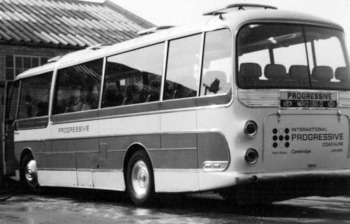 Research shows that Mr
Harris's company was International Progressive Coaches,
based at Waterbeach. Mr Harris also owned Camtax, a taxi
firm.
This is probably not the
model of coach that Dick refers to - no front view - but if
anyone has the right photo please let the editor know.
information and image source:
please click image: Norman Long SG56 actually took this
photo - see end of this page!
See also Peter's account of the trip in the Summer 1965 Soham Grammarian which is accompanied by Brenda Malkin's account in the EHS 1965
magazine - and with a photo now added from Jon Evans SG'61'
taken by his wife, then Jean Williams.
We set forth from here on a Thursday [August 20th according to EHS]. We were about 20 miles from Koblenz where we to have an overnight stop on the Friday when there was a loud bang and the windscreen went! It gave a whole new meaning to air conditioning. Being a new and modern coach
it had a big wrap-round windscreen. Virtually all the
coaches on the Continent then had split-screens. We got to
Koblenz at about 5 in the evening. Our driver was a chap
from Broughton near Huntingdon [Dick was school in Ramsey
...]. He phoned Paddy "Look, we've got no windscreen, can
you sort us out?". Paddy called back a couple of hours
later. He'd managed to locate a new windscreen for us. In
Newcastle! (Laughter)
Anyhow, with further
negotiation he managed to get this windscreen on to a plane
from Newcastle to Stuttgart. He had arranged the
accommodation for us in Koblenz, he knew the proprietor of
the hotel and this chap had a vehicle large enough to carry
this enormous windscreen. It was to be collected from
Stuttgart at 5.30am and brought to Koblenz where two
gentlemen had been laid on to fit it.
It didn't quite go as smoothly
as that. The plane was diverted because of fog and Customs
wouldn't release the windscreen until 8am because it was
'non-perishable goods' - they should have seen the original
one!
Anyhow they got back to Koblenz at about 10am with this windscreen. The two chaps were going to fit it, with Peter and I acting as labour. We struggled to hold this thing in position while they fiddled and messed about with it. By about midday on the Saturday they decided they couldn't do it. We were due in Innsbruck that evening. Peter and I left the group in the hotel and the driver took us into the town - everywhere was closed. Peter had the inspiration to go to what you might call a little transport cafe on a bomb site. We went in with our best German, which was negligible, and managed to explain what our problem was. Two chaps sitting up the corner said "Yes, we'll fit it for you". They came out and we struggled for the best part of 2-3 hours with the help of these two characters and got the screen fitted by about 4pm. We went back and picked the group up and set forth for Innsbruck. We had had very little to eat
so we decided the best thing was to stop at a restaurant for
a reasonable meal as we had overnight travel in front of us.
We got to Innsbruck at about 9 the next morning. The hotel
allowed us to use the rooms we should have used overnight
and we freshened up and had breakfast before continuing on
to Venice, where we stopped for a couple of nights. The
itinerary gradually got back on course.
I remember from a previous trip to Arles that Peter was not very good with heights. We recently revisited the Pont du Gard - its all different from when Peter and I were there, Health and safety have taken over and you can't do this and you can't do that. Back on that Arles trip we had clambered all over it. We got up to the top to walk across it and Peter was so terrified he was on his hands and knees and was glad to get down. When we got to Pisa we decided we'd go up the Leaning Tower. Nobody wanted to miss out, Peter least of all. I can see him now, clinging to the inside wall and hardly daring to look out as we approached the top of the Tower. On the way home the driver had the courtesy to tell us that for 50 miles through parts of the Alps we had no brakes! We all got back in one piece and I think we had a most memorable journey and it was really thanks to Peter, his inspiration and the itinerary that we set up but it was a little bit tiring to say the least. In 1972 we parted company as Peter and many of my colleagues from the Grammar School went through to Ely. Just four of us remained here - Peter Taylor, Tony Russ, Lionel Hart and myself. We remained in contact. I will always remember those years of friendship and guidance in the 60s and especially our trip to Italy. Thank you". (Applause)
Frank : Thank you,
Dick. If any of you you know someone who was on that
trip to Italy, we’d like to hear their stories.
Frank read
several contributions:
Michael Yeomans SG60 who
is now in New Jersey was not able to come over this year.
"Although I was not amongst the artistically gifted I
always enjoyed his art classes since he was such a
creative person and very patient with those of us who did
not share his talents.
He always did an amazing job in designing the sets and costumes for the school plays. I remember particularly participating in Amahl and the Night Visitors when I played a peasant girl and had to wear a smock! It was a great pleasure to talk to him at the 2012 Reunion Dinner marking the 40th anniversary of the closing of SGS". David Woodroffe SG60
"My memory of him was of a kind and approachable teacher.
I would not say that of some of the "old school" of teachers that were still there in my time." Richard Formby SG68
"Please pass on my and my wife Kay’s condolences to
Tamaris, her sister Gemma, and family. I knew Peter, Tamaris
and Gemma back in those days very well - my wife, Kay, was a
friend back then of Gemma’s. I spent many, many good times
at Peter’s amazing (very old and recall spooky) house with
Tamaris and Gemma. Great weekend parties!! I hasten to add
that the parties were when I had left SGS/SVC and was at the
6th Form in Ely! So the party drinking was legal,
just."
Alan Dench SG67 who is
here tonight, has asked me to say: "Peter Askem taught art
during my time at Soham (1967-1972). I remember, being
a keen oil and watercolour painter as I still am, enjoying
his lessons and helpful critique.
I also recall that he had
beautiful handwriting."
Paul Dunham SG59 "Once again the dinner clashes with the Ploughing Festival at Prickwillow Museum which we are involved with, so although I would have loved to witness the tributes to Pete Askem, sadly, as a Trustee I am committed to that event. One of the things I will always remember him for was during lunch in the canteen – I looked down on my dessert to find a moth floating in the custard, so I took it to Peter Askem. He responded – ‘ Don’t tell everyone boy, they will all want one!" Professor Rod Else SG56
"Unfortunately, I am unable to attend the reunion event this
year. This is particularly upsetting as I would have wished
to pay tribute to Peter Askem's memory.
Although I was a (sort of, if
you listened to "Uncle Ted"!!) scientist when I reached the
dizzy heights of "A" Levels and career aspirations, I was
able, along with one of my fellow biologists (Grant Hood) to
do an O Level Art course with Pete Askem. Those sessions
provided me with some wonderful "respite" from Physics at
which I laboured as I was/am useless at maths!) and the
struggle of Chemistry (with "Daddy" Ford).
We had great chats with Pete about all sorts of topics, not remotely to do with the serious side of art but nevertheless very good general education! One of the more amusing aspects of doing the O Level course was that I elected to make a coil pot as my piece of craftwork. The pot started as a small amphora-like vessel but by the time I had got half-way the thing had turned into a monster Ali Baba-like vessel. At the sight of this, together with my requests for ever more clay, Pete remarked that at the rate I was going I was on course to totally exhaust the Education Services reserves of clay in East Anglia. The "pot" did reach its gigantic culmination, however, to be successfully fired and triumphantly presented at home, where it held large floral arrangements (rather than wine!) for many years. Aside from all that Peter was always greatly supportive and always positive about my attempts at oil painting extra-curricularly. The other anecdote I offer was when I was further down School when Peter Askem and the lovely Mrs. Askem came on one of our school trips abroad. We were en route to or from Austria and I, desperate for some English reading matter had purchased a cheap "rag" ( probably like Hello or worse) during a stop at a railway station. On the cover of the said mag. was a rather scantily-clad and voluptuous girl. The Askems were in the same railway compartment. I became aware that Mrs. A was nudging Peter and raising eyebrows cast in my direction. Eventually, Pete was induced to demand of me as to the nature of my reading matter! I had to hand it over to let them have a look - clearly, they had reckoned that I was into a pin-up or porn mag! Imagine the look on their faces when they discovered that there was nothing contentious within the covers of the mag. other than society gossip! Pete said something like "Oh, well that's alright then, Else". I always wondered if he was disappointed that he did not have sufficient grounds for confiscating it! It was great to be taught by someone who actually made artworks as well as teaching. I always remember going to an exhibition at Ely Cathedral and there on a table were several pieces of lovely pottery - name of artist? Yep, you guessed it - Peter Askem". Leon Kitchen (History 51-57) says "We were very sorry to hear of Peter’s death. He had a warm, friendly and engaging personality. Barbara remembers his pottery class with pleasure. Peter and I only overlapped for a mere three years, 1954-57. Peter and Lynn following us at ‘The Nut Walk’, one of the two staff houses built in 1951 on Sand St. The first occupants were Ken ‘Dilly’ Drake and family He was an ex-SGS boy from Ely and was Head of Art. He left in 1954 to take a similar post at Kidbrooke, a new London Comprehensive. So Peter moved into his job and we moved into his house for the following three years before leaving for The City School, Lincoln." John
O'Toole (English 63-66), Former Foundation Chair
of Arts Education at the University of Melbourne, writes
"I’d have liked to very much this year, to come and pay
respects to Peter Askem, who I was sad to hear had died.
Until we downsized a couple of years ago, we had two of his
beautiful decorated slipware bowls, that we had as wall
hangings, so a bit of his own artwork has made it to the
other side of the world.
I'm afraid I don’t have any
mementos or photos - or even smart anecdotes. I have an
abiding generic memory, though, of a really thoughtful,
witty and civilised human being. As a totally
wet-behind-the–ears teacher, I found Peter was a very good
friend and generous mentor – and of course we shared a
passion for all the arts. What I learned from him about
visual arts education has paid off in spades in recent
years, as Lead Writer for the Arts in the Australian
Curriculum I’ve had to pretend I know about visual arts
education … most of which I remember from Peter’s knee
(metaphorically!)."
Frank: If anyone has
further recollections of Peter please do get in touch so we
can add them to this page.
Outside and beyond SGSThe Way We Lived Then - Recollections from four centuries of British Life, by Edward Armitage. (Robson Books, 2001). Drawings by Peter AskemEdward Armitage, Peter's Headmaster at Soham Grammar School, died in 2001. He had compiled an anthology of memoirs chronicling British life in the seventeenth, eighteenth, nineteenth and early twentieth centuries. Later that year this book was published, copiously illustrated by Peter.
Some more of Peter's work Mrs
Judith Wood, whose late husband Gareth
taught Chemistry 1964-72 wrote:
"Peter used to send a Christmas card to us each year. They were his own work and Gareth put some of them together for an exhibition." Judith was unable to attend the Lunch but kindly provided the framed Christmas cards. Judith
remembered that she had commissioned a watercolour from Peter
(we couldn't get rid of all the reflection in the glass of
this framed item):
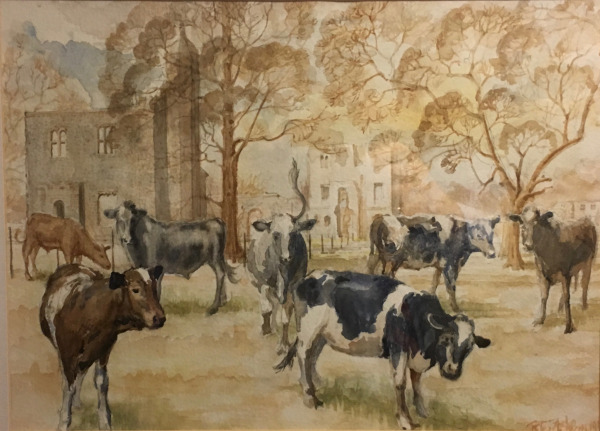 Frank:
Peter did a lot of work in adult education in the many places
where he lived.
Those who I
have heard went to Peter's adult classes include John Abbott's
widow Judy, Leon Kitchen's wife Barbara and Mr Peter Scott.
Barry
Parr SG62 provides a contribution from his daughter
Rebecca Lyne, who saw Peter from the other side, as it were:
Mention has
already been made of Cambridge Assessment.
Tamaris:
I want to say to everybody that he loved teaching, he loved
here teaching boys, he put his heart and soul into it. In his
middle years he began to go in slightly different directions
which I will talk about.
It was the best period of his life. He was very enthusiastic, he threw himself into all of the plays and productions. He did extra lunch work, he did evening classes for the youngsters. At this point he was headhunted by Cambridge University who were looking for people who were running outstanding Art Departments to join in the development of Art Education in other countries.
Each
country of course has its own fantastic tradition of art. He
would work in close contact with the local masters of that art
to incorporate that into the syllabus alongside that of the
western world. He was invited by Cambridge University
Examinations Board to join the team of art specialists who
wrote the syllabus for the exam systems in the UK and also the
International Exams.
He became
more involved with this work as the years went by and
eventually retired from teaching to concentrate his
efforts as he became Chief Examiner.
He was very good at it, terribly enthusiastic. His first visit for the Exam Board was to Kenya and we saw a family photo with a Kenyan visitor earlier on. 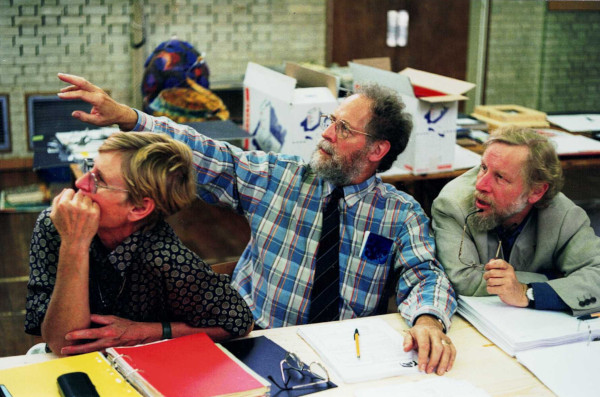 Peter
marking work in Cambridge
AT REUNIONS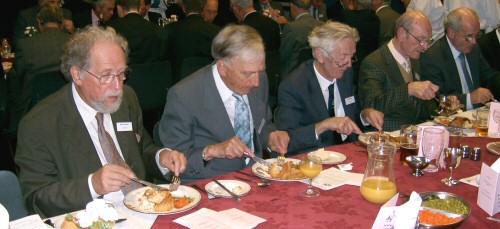 At our 2004 Reunion with, L-R: with Leon Kitchen (History 51-57), Rex Waller (Latin 49-60) and Edmund/Ted Quinn (Physics 50-56) 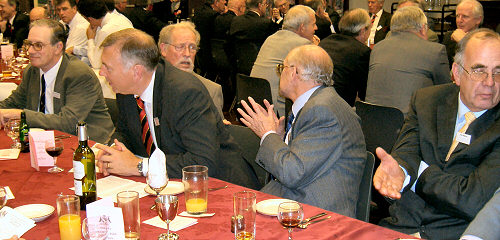 At our 2005 Reunion: L-R Mr Bryan Hollamby - Ed Reed SG67 leaning forward - Mr Peter Askem - Mr Gareth Wood - Mr Alan Mason 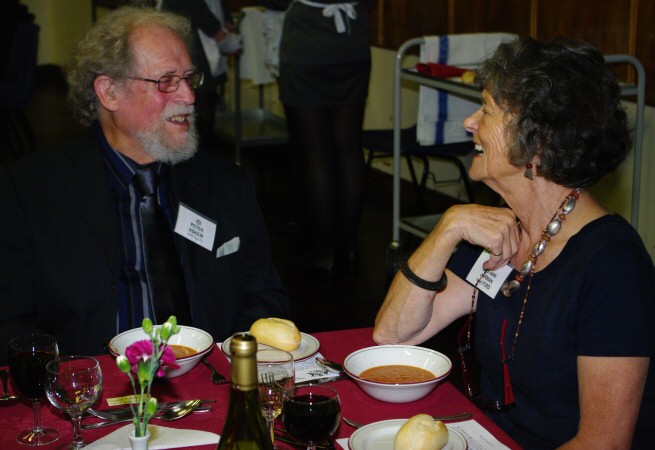 At our 2009 Reunion, with Ann Jarman 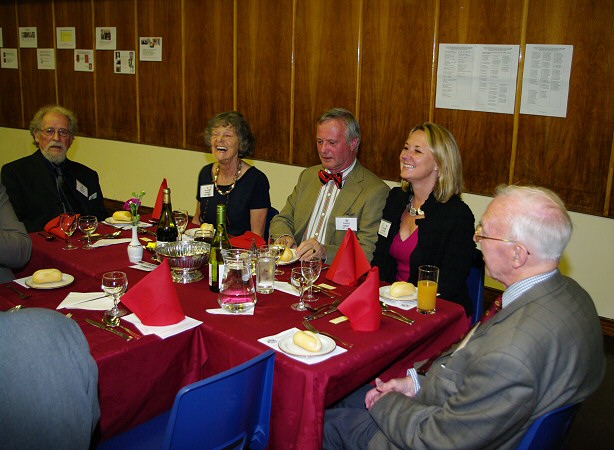 Another from 2009, with Ann Jarman, Chris Bent SG53, Dr Carin Taylor and Mr Gordon Hemmings (English 58-66) Some of Peter's work
He
specialised in this extruded slip work. Actually I think he
used an icing nozzle. You probably saw him squeezing it out.
Looking at the chargers - I don't know if you ever saw him doing it but he would press pencils, stones, and twigs into the clay to make a texture and then he would squeeze out a pattern from an icing nozzle over the top. He was very interested in
the mediaeval period and in a lot of his work you can see
that kind of feel.
He was very
generous with his work and he would distribute it amongst all
of us quite often and of course we paid no heed to it.
There's only a little bit left in the kitchens of all of us children. I’ve
brought a sample of his etching prints in a small portfolio,
as I taught him the etching process after I finished my
postgrad in printmaking.
He enjoyed
it tremendously and had quite a few exhibitions both locally
and further afield.
He did many etched images of Ely Cathedral and loved old churches and abbeys. His main interest artistically was based in the mediaeval period which can be seen in the faces and figures in his ceramic work, and the ancient stonework which lends itself to the etching process, and his prints of old religious buildings in East Anglia and Norfolk After he retired his work mostly consisted of watercolour paintings and he continued working for as long as he could until his eyesight began to fail in his mid 80s. His lifetime involvement in the arts and the many pieces of ceramic work prints and watercolour paintings are wonderful legacy. Reredos in the church of St
John the Baptist, Stiffkey, Norfolk
"The reredos backing the communion table is a painting by Peter Askem of the Last Supper, flanked by alpha & omega panels and two relief crosses added in 2006 in memory of churchwarden, James Leach."
InspirationWe have a
couple of contributions from Grammarians whose path in life
was partly shaped by Peter.
Patrick
Padget SG62 – Patrick has injured his leg and so has not
been able to attend though booked.
His tribute
to Peter is read by Barry Parr SG62
"My
thoughts about Peter Askem by Patrick Padget SG62
This is an homage to an amazing man. While I
was studying at Soham Grammar School, Peter Askem gave me a
gift which has completely transformed my life.
He gave me an absolute belief in my own artistic and creative abilities and encouraged me to draw and paint obsessively. This was enhanced by other brilliant teachers, including Mr Bozeat, who transmuted a slightly introverted boy from The Fens, who was destined to be a tractor driver, into an artist and launched him off on a sky-rocket to the future. I left
this place in 1969 and went on to study Art & Design in
Cambridge then at Chelsea School of Art.
Eventually, I founded my own creative business in 1981,
working for a wide spectrum of clients in the UK and all over
the world, including The BBC,
Marks & Spencer, The Royal Opera House, The NHS, Channel 4, BandAid and Disney. By 1990 we had an annual turnover of over £3 million. In 2006, after a family
tragedy, I fell apart and lost everything.
However, working with my brilliant wife Patricia and supported
by friends and family, I began to focus on painting and
drawing again.Very quickly we began to have paintings and prints shown all over the world. Lady
Marina Vaizey, art critic for The Times and
Turner Prize judge, was our patron. She said: “The Padgets
have created something enigmatic and beautiful which is also
timeless.”
While our work is by no means biased towards The Bard, he has by devious means led us to eventually move to Stratford upon Avon where we have set up a brand new venture, next to Shakespeare’s Birthplace called The 2be Studio & Gallery where I am beginning the next phase of my life. I just want to say “Thank you Peter Askem for your wonderful gift.”" Stephen
Murfitt SG65, who was mentioned earlier by Dick Bozeat,
could not be here today as he had a major commitment in York
this weekend. He has recently moved from Wicken to near
Huntingdon.
Like
Tamaris he is associated with Cambridge Assessment and between
them Peter's early pot seen earlier was provided for display
at the recent 50th Anniversary Exhibition at the Old
Fire Engine House in Ely, founded by one of
our Guests of Honour, Ann Jarman, daughter of Mr CJ Ford.
Speaking of
whom there is another connection in that Ann's daughter Lucy
and Peter Leonard SG65 have reopened the Red
Lion as a restaurant and bar here in Soham.
Peter has had a very successful career in design and is
grateful for his namesake's influence.
Tamaris:
Dad worked really, really hard. He took his work really
seriously and as an art teacher myself it's quite
extraordinary to hear from a lot of people that "art is an
easy subject".
He would
put such a lot into the teaching. He would do evening classes
then come home and work for hours and hours at the potting
wheel. My mother would send us in sometimes to get him out, to
get him to eat. His hands would be bleeding from the wheel, he
was so engaged in what he was doing - 100% commitment.
He was an inspiration to the
rest of us. Many of the children, I'm the eldest, followed
him into the art world.
Thank you for asking me to
be here today. (Applause)
Frank:
Thank you Tamaris.
If Peter
were with us today, what Art resources would he find and
what would he see of the work being done by the 11-15 year
olds?
Over to Dr
Carin Taylor:
The school
benefits from three outstanding Art rooms, complete with kiln
and dark room. All students study fine art and
pottery as part of their curriculum in years 7 and 8.
Higher up the school, students have the opportunity to
specialise and will produce their final pieces in a range of
media, including ceramics and photography.
As a result of the strategic partnership Soham Village College enjoys with the Cambridge University Museums, every student in year 8 has the opportunity to visit the Fitzwilliam Museum and see artefacts which are then used as the basis of curriculum in a range of subjects, including maths, English, Modern Foreign Languages, and Design and Technology. Last year
students raised over £600 to purchase a printing press,
inspired by their visits to the Curwen Print Study Centre in
Cambridge. Students regularly enter and do well in the
school competition run by Babylon Gallery in Ely; in 2018 they
took all first prizes in the KS4 section.
The
Fitzwilliam Arts Lab is full of students during lunch break
and after school. Art continues to thrive in Soham as
can be seen below.
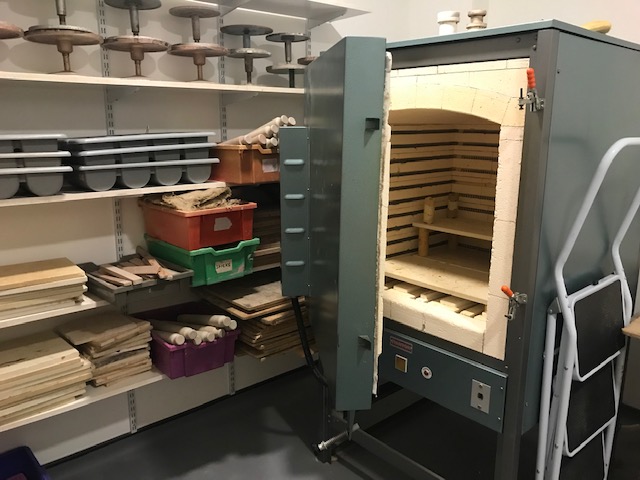
Frank:
Thank you again to Tamaris, Barry, Dick and to all those who
have provided contributions,
and to Carin for showing us that Art continues to thrive and excel here. I hope there
will be more that we can add to this web page celebrating
Peter's life.
24/10/18 Norman Long SG56 I was reading
through the very interesting report relating to Mr Peter Askem
who was a teacher that I really liked, in fact, had it not
been for him teaching calligraphy, and suggesting that I
should use an italic nibbed fountain pen, then my handwriting
may never have developed satisfactorily. I had been singled
out for very poor handwriting by more than one master up to
that event. Feb-Apr 2019 Mike Hallam SG51: I have not kept in touch with the SGS website in the last couple of years and missed out on the input to the talk on Peter Askem. Peter and I knew each other very well up to the time I left school in 1959. We even worked out that we must have stood at the same bus stop (me 10 and Peter 18-ish) while he attended the Perse School and I was at St. Andrew’s, right in the middle of Cambridge. I knew Peter and his first wife Lynne. I can still remember his painting of a tree in blossom above their fireplace. My parents gave them a miniature Pekingese that slept its nights away in the fire ashes of the same fireplace. Thank you for putting me in touch with Peter Askem’s daughter Tamaris. According to her the very tiny Pekingese used to sit in her pram and guard her fiercely when she was a baby. I have never forgotten a Eureka Moment in my art education. I was making a very poor attempt at a life drawing of a fully clothed fellow grammar school boy when Peter walked up behind me, looked over my shoulder, and said “Here, let me show you.” In his hand the pencil point moved from the back of the model’s head to just below the waist in less than a minute. The line changed from thick and heavy to thin and pale and it would disappear altogether. In that demonstration I learned about line quality, light and shade, emphasis and movement, even a little perspective. As he got up to move away he said "Of course you do realise that there are no lines in Nature. We just use lines to signify where a mass ends and a space begins. It’s a language". From that day I could produce a competent life drawing. As a 6th former SGS paid me £10 per term to be Peter’s pottery studio technician. I still have the black and white photos of my 1958 A level entries for the ceramics exam done under Peter's supervision (Mike has since added that these were taken by WAG Burroughs professionally at his studio in Soham):
I was a boarder at SGS. Uncle Ted appropriated my china clay model of a mediaeval woman falconer and kept it on his mantelpiece for years. I think the last I saw of it, the falcon had fallen off her wrist. There was a long stretch of years when I lost touch with Peter and by the time we were back in contact through this website his life had changed. Mike has also made an interesting contribution about his time at SGS (some of which has come from memories shared by Mr Leon Bill Kitchen) and his career in education - see via Scrapbook, 1950s 23/24 December 2019: Mr Denis Tokley writes: My
brother passed away a few weeks ago and I suddenly remembered
that he and my parents used to know Peter Askem, when
he was a boy at The Perse School, Cambridge.
page created 12 Oct 18: last updated 8 Jan 20:
21 Apr 20: 21 May 20
2018 lunch photo report |
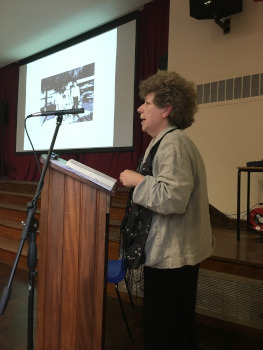
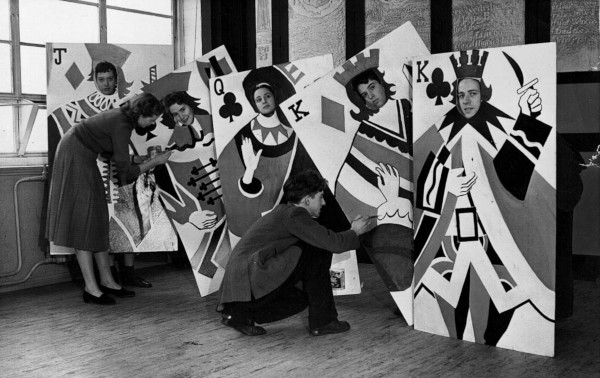
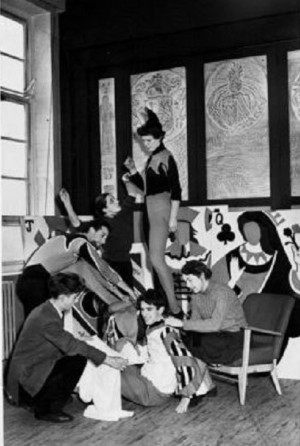
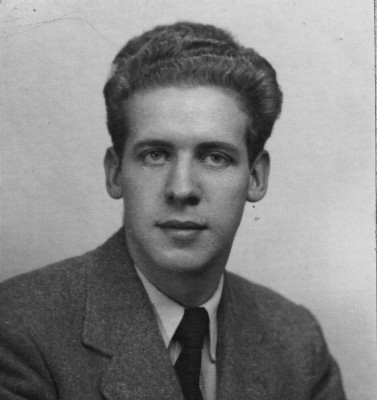
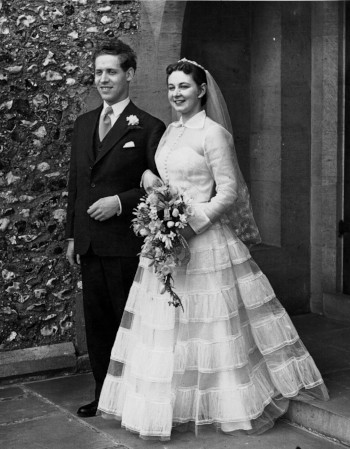

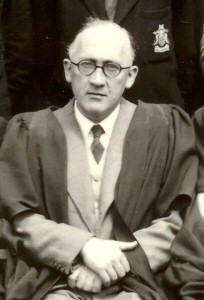
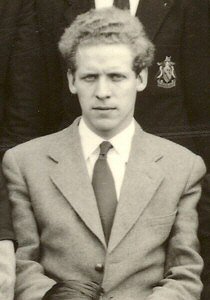
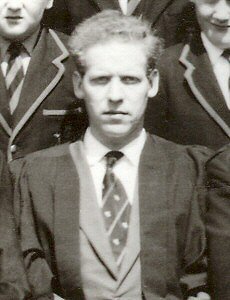
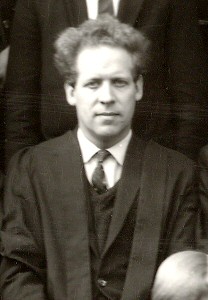
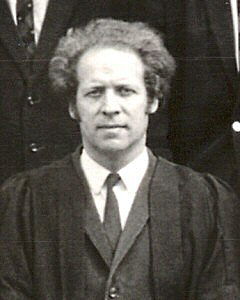
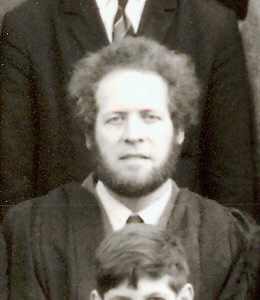

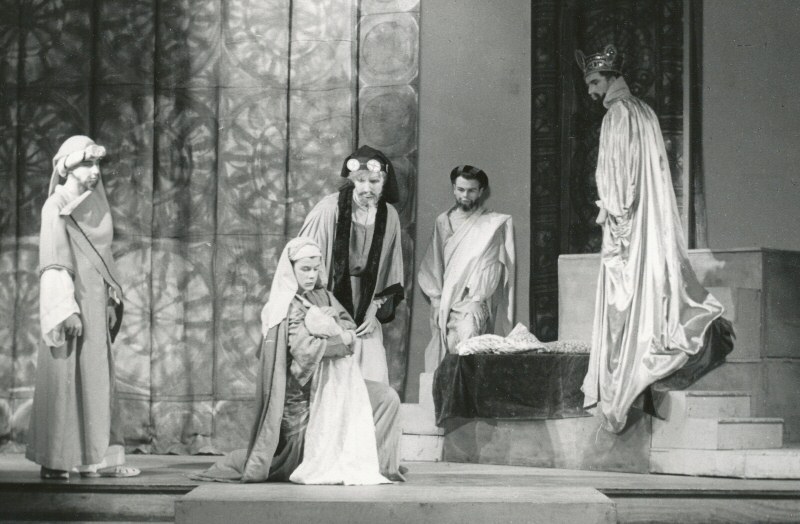
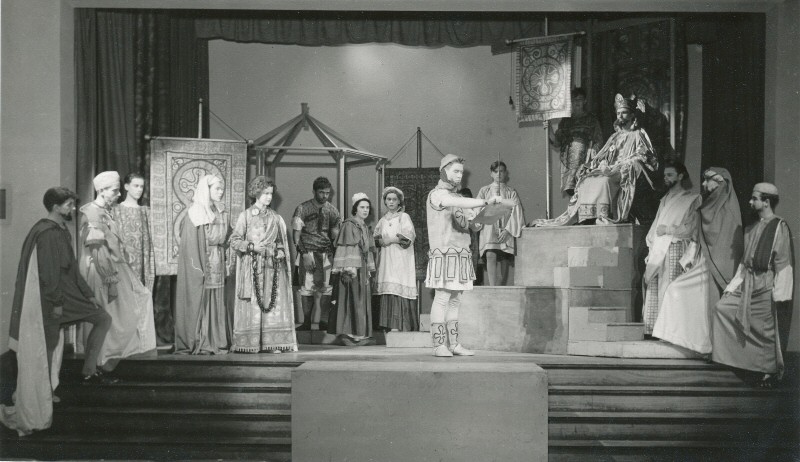
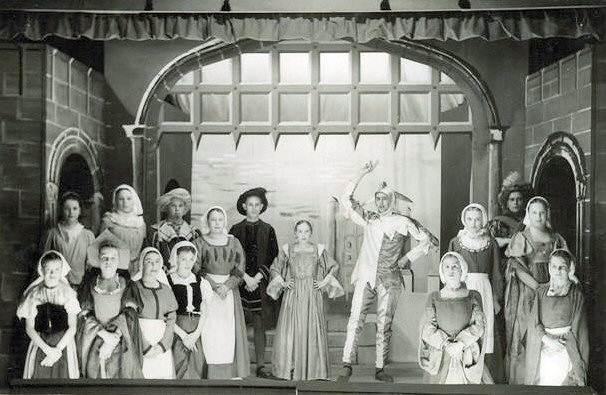
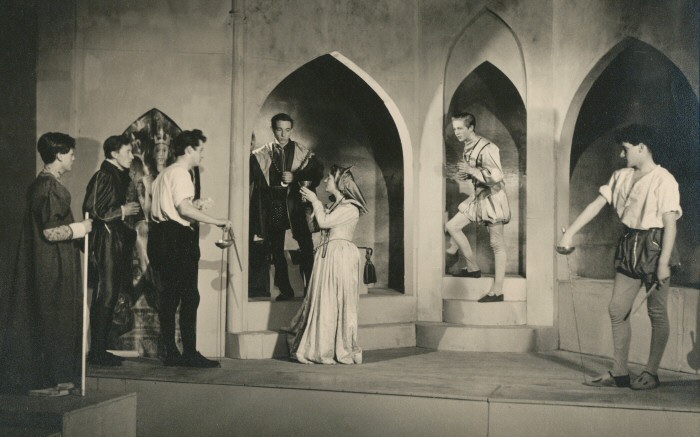

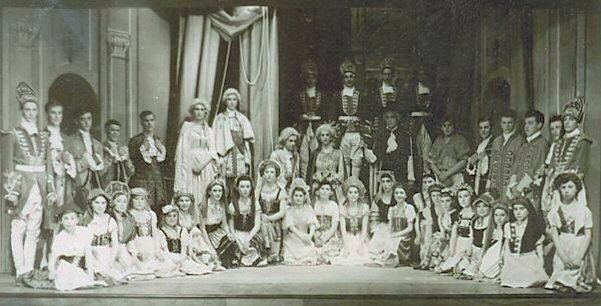
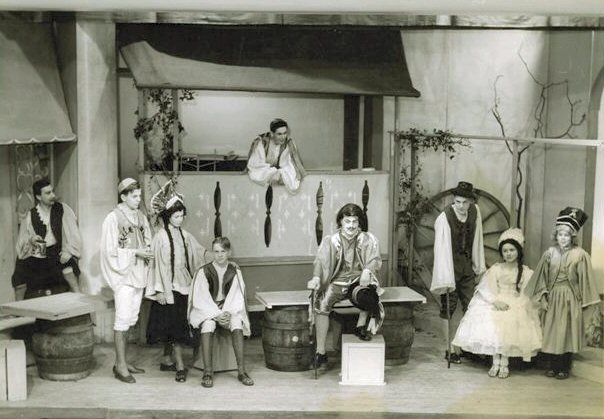
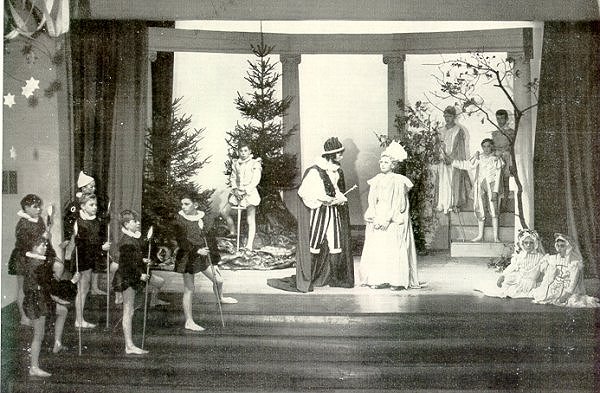
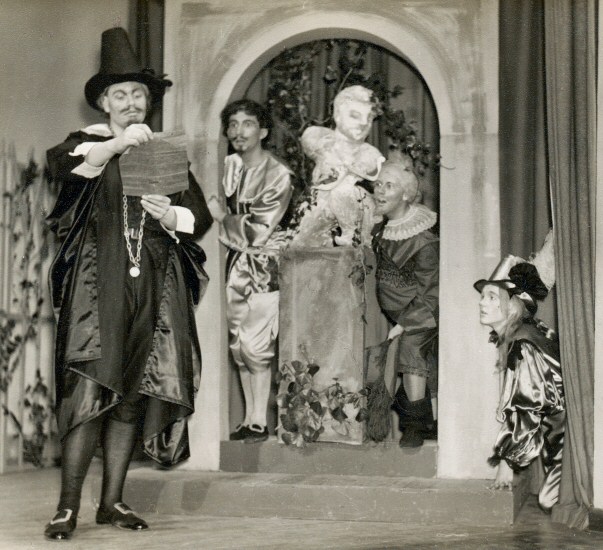
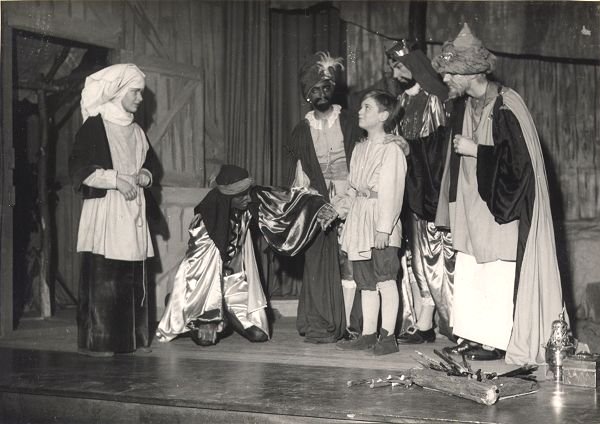
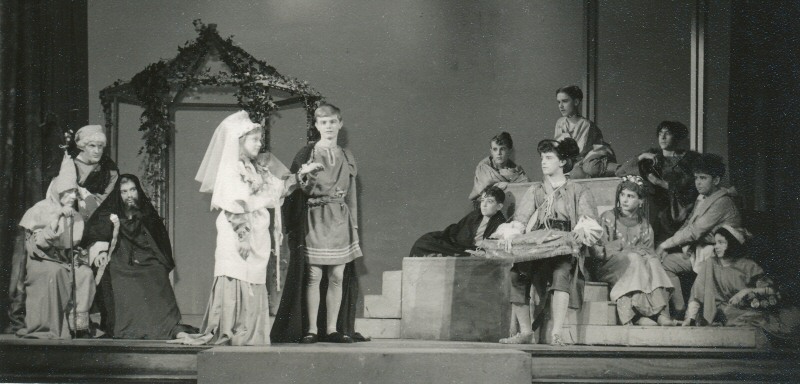 1962
The Winter's Tale
1962
The Winter's Tale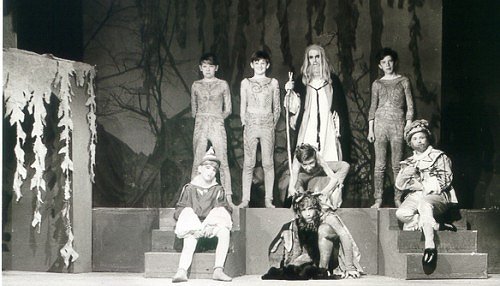
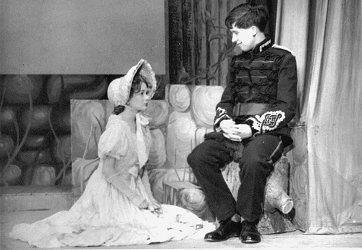
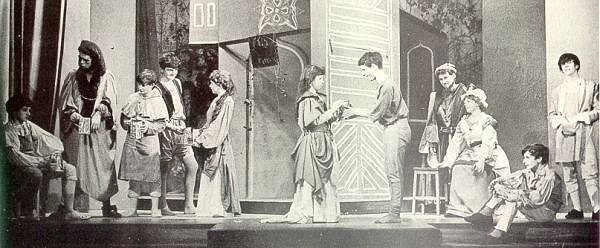


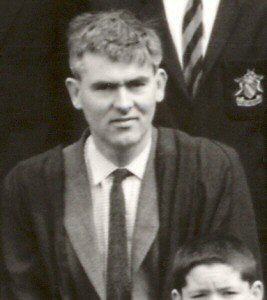
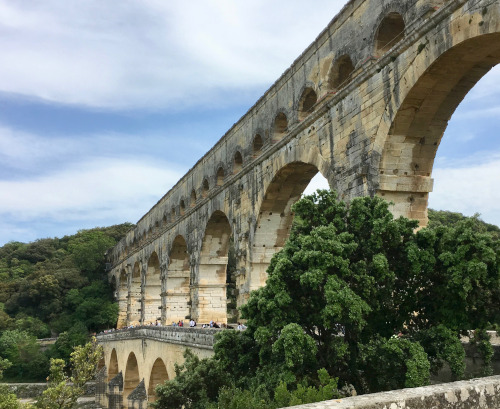
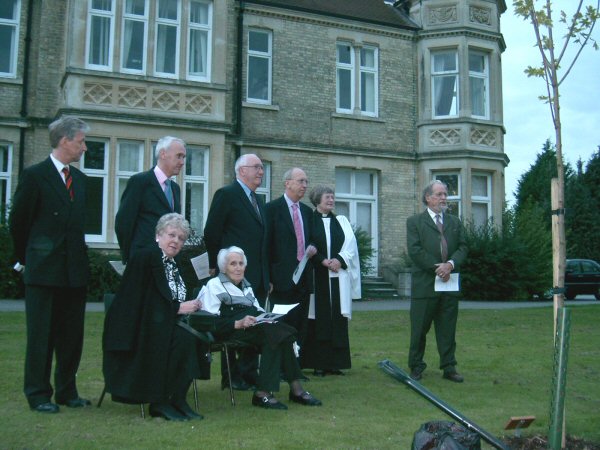
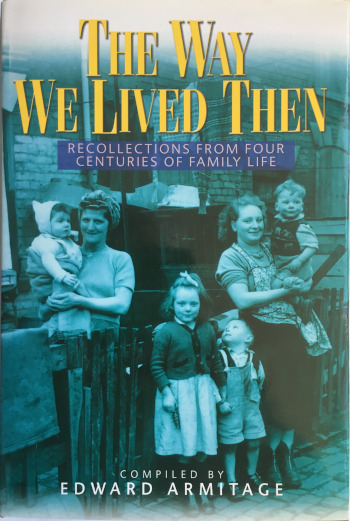
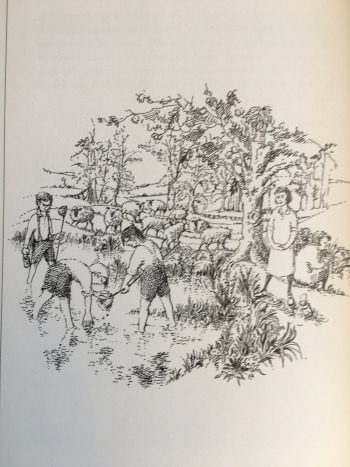
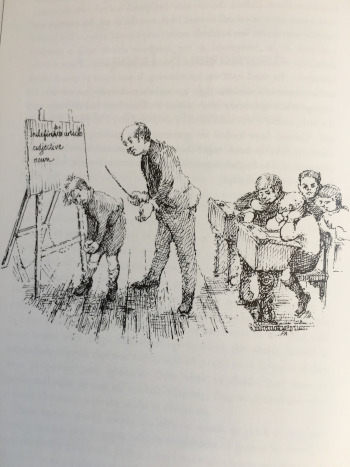
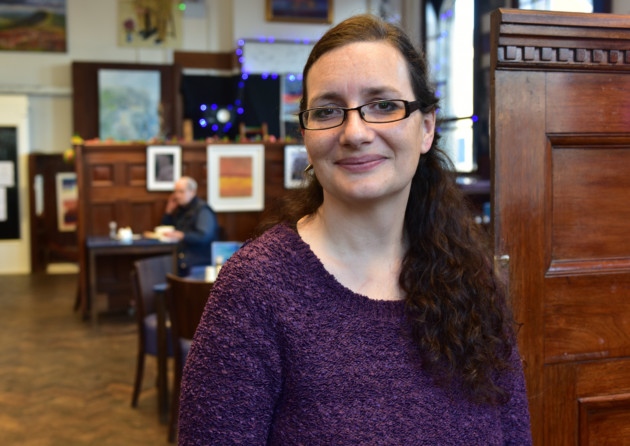 Rebecca
Lyne BEM
Rebecca
Lyne BEM Photo
taken by Peter and used in the
Photo
taken by Peter and used in the 
